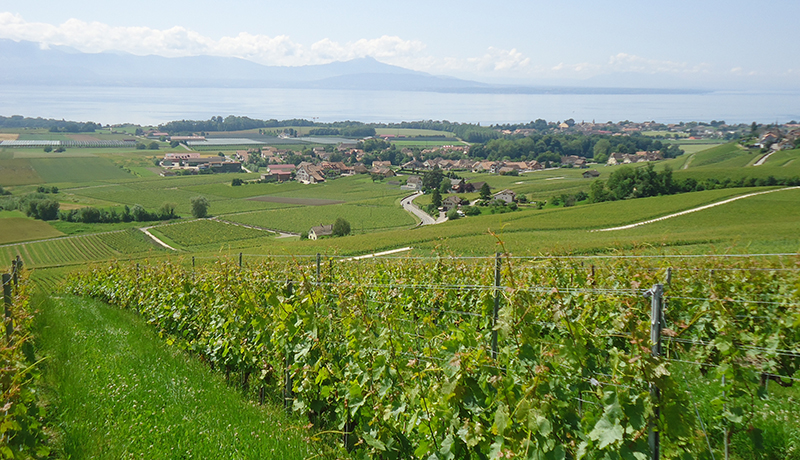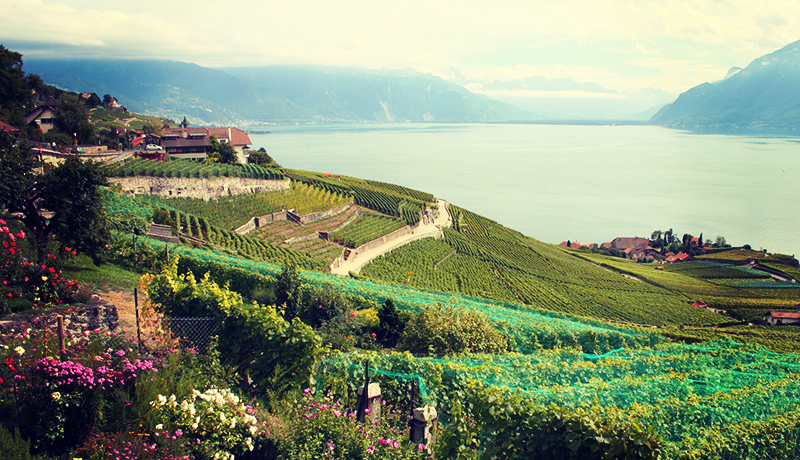

La Côte
Photo Courtesy of Michael Cervin
Switzerland has very distinct wine regions and a surprisingly long history with vines: The Romans first planted grapes here more than 2,000 years ago. Sandwiched between Geneva and Lausanne, the La Côte (“the coast”) wine region is just 28 miles long, yet it is the biggest winemaking area in the region, consisting of 5,000 acres of grapes.
There are over 125 wineries here, which is impressive considering that most of the world isn’t even aware that Switzerland has a wine industry. Only two percent of Swiss wines are ever exported; they are almost all consumed by the Swiss and the French, which explains why you’ll rarely find any in New York restaurants. But, Switzerland has more indigenous grapes than any other country aside from Italy — grapes you’ve never heard of like plant robert, petit arvine, humagne blanc and cornalin.
When visiting Switzerland, there are numerous Swiss varietals to try when you’re at local wine bars and restaurants. Better still, a mere 20-minute train ride or 30-minute car ride from Geneva puts you squarely between Lake Geneva and the heavy, gravelly soils of the lower slopes of the Jura Mountains. The majority of wineries are near highway E25/62, known as the Route du Vignoble, which runs parallel to the train.

A Pathway to Pours, Photo Courtesy of Michael Cervin
It is postcard perfect in La Côte: blue skies, sun settling on green vineyards that race down to the lake as the cobalt water shimmers in front of the Alps. Vineyard plots are organized, more or less, by the streams and creeks that crisscross through them. Because of these natural demarcations, walking paths have been constructed through the vineyards, enabling tourists, walkers and bikers to traverse the landscape and visit small, family-owned wineries with ease.
La Côte has over 30 chateaux to see along meandering footpaths that allow you to casually walk from property to property — it has very much a different feel than more spread out wine regions such as Napa or Bordeaux.
As is true in the whole of the Lake Geneva region, chasselas, the crisp, acid- and mineral-driven white wine, is king. You’ll also find gourmet products, unique arts and crafts, and opportunities to meet cheese mongers, butchers, bakers, farmers and local artists. Local food specialties highlight the wines: the ubiquitous filets de perches (the local white fish from Lake Geneva); malakoffs (cheese beignets made with white wine and eggs); papet vaudois (a hotpot made from leeks, potatoes and sausage); and for dessert, tarte à la résinée (a tart made with apple and pear juice reduction).
Typically throughout Switzerland, if you buy wine at a winery, the tasting is offered for free. Specifically in the Morges region, a mere payment of 15 Swiss francs (roughly $15.38 USD) allows you to taste six wines without any obligation to purchase a bottle —many people, however, grab something to take home. Most of the wineries are reasonably small and not set up for major tours. Some are only open for tastings on Fridays and Saturdays; however, most of them will oblige you any time of the week if you phone ahead.
Places to Visit
In the village of Begnins, Domaine La Capitaine is a charmer. A hybrid between riesling and freiburg and created in 1968, the winery’s Johanniter is a white wine you will find only here. The Pinot Noir Vieilles Vignes is another suburb wine, with soft, seductive and subtle berry flavors.
For nearly 50 years the Paccot family, proprietors of Domaine La Colombe, has been exploring innovative blends like its La Colombe Rouge, a blend of different native grapes including gamaret, garanoir, pinot noir and syrah. You’ll also find blended whites like Amedee, made from savagnin, chardonnay, doral and chasselas. Other varietals include sauvignon blanc, syrah, gamay, pinot noir and even grappa and brandy.
At Domaine Henri Cruchon, the majority of the vineyards are farmed biodynamically. Grape varieties from the estate vineyards include sevagnin, an ancient pinot noir variety typical of the Morges region, and also new varieties such as mara and better-known wines like chardonnay, sauvignon blanc and cabernet sauvignon.
